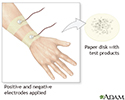Sweat electrolytes test
Sweat test; Sweat chloride; Iontophoretic sweat test
Sweat electrolytes is a test that measures the level of chloride in sweat. Sweat chloride test is the standard test used to diagnose cystic fiborsis.
How the Test is Performed
A colorless, odorless chemical that causes sweating is applied to a small area on an arm or leg. An electrode is then attached to the spot. A weak electrical current is sent to the area to stimulate sweating.
People may feel a tingling in the area, or a feeling of warmth. This part of the procedure lasts for about 5 minutes.
Next, the stimulated area is cleaned and the sweat is collected on a piece of filter paper or gauze, or in a plastic coil.
After 30 minutes, the collected sweat is sent to a hospital lab to be tested. The collection takes about 1 hour.
How to Prepare for the Test
No special steps are needed before this test.
How the Test will Feel
The test is not painful. Some people have a tingling feeling at the site of the electrode. This feeling may cause discomfort in small children.
Why the Test is Performed
Sweat testing is the standard method for diagnosing cystic fibrosis. People with cystic fibrosis have higher amounts of sodium and chloride in their sweat that are detected by the test.
Cystic fibrosis
Cystic fibrosis is a disease that causes thick, sticky mucus to build up in the lungs, digestive tract, and other areas of the body. It is one of th...

Some people are tested because of symptoms they are having. In the U.S., newborn screening programs test for cystic fibrosis. The sweat test is used to confirm these results.
Normal Results
- A sweat chloride test result of less than or equal to 39 mmol/L in an infant over 6 months old probably means cystic fibrosis is very unlikely.
- A result between 40 to 59 mmol/L does not give a clear diagnosis. Further testing is needed.
- If the result is 60 mmol/L or greater, cystic fibrosis is present.
Note: mmol/L = millimole per liter
Normal value ranges may vary slightly among different laboratories. Talk to your health care provider about the meaning of your specific test results.
Some conditions, such as dehydration or swelling (edema) can affect the test results.
What Abnormal Results Mean
An abnormal test may mean that the child has cystic fibrosis.
References
Borowitz D, Robinson KA, Rosenfeld M, et al. Cystic Fibrosis Foundation evidence-based guidelines for management of infants with cystic fibrosis. J Pediatr . 2009;155(6 Suppl):S73-S93. PMID: 19914445 www.ncbi.nlm.nih.gov/pubmed/19914445 .
Egan M. Cystic fibrosis. In: Kliegman RM, Behrman RE, Jenson HB, Stanton BF, eds. Nelson Textbook of Pediatrics . 19th ed. Philadelphia, PA: Elsevier Saunders; 2011:chap 395.
Farrell PM, Rosenstein BJ, White TB, et al. Guidelines for diagnosis of cystic fibrosis in newborns through older adults: Cystic fibrosis consensus report. Journal of Pediatrics . Aug 2008;153(2). PMID: 18639722 www.ncbi.nlm.nih.gov/pubmed/18639722 .
-
Sweat Test - illustration
The sweat electrolyte test is a test that measures the level of chloride in sweat. In children, increased sodium and chloride concentrations in sweat can indicate cystic fibrosis, an inherited disease that affects the respiratory and digestive system.
Sweat Test
illustration
-
Sweat test - illustration
The sweat electrolyte test is performed to determine the amount of chloride that is excreted in sweat from the body during a certain period of time. The test may be performed on infants to determine if cystic fibrosis is present. Children with cystic fibrosis have increased sodium and chloride concentrations in their sweat.
Sweat test
illustration
-
Sweat Test - illustration
The sweat electrolyte test is a test that measures the level of chloride in sweat. In children, increased sodium and chloride concentrations in sweat can indicate cystic fibrosis, an inherited disease that affects the respiratory and digestive system.
Sweat Test
illustration
-
Sweat test - illustration
The sweat electrolyte test is performed to determine the amount of chloride that is excreted in sweat from the body during a certain period of time. The test may be performed on infants to determine if cystic fibrosis is present. Children with cystic fibrosis have increased sodium and chloride concentrations in their sweat.
Sweat test
illustration
Review Date: 4/21/2015
Reviewed By: Neil K. Kaneshiro, MD, MHA, Clinical Assistant professor of Pediatrics, University of Washington School of Medicine, Seattle, WA. Also reviewed by David Zieve, MD, MHA, Isla Ogilvie, PhD, and the A.D.A.M. Editorial team.


